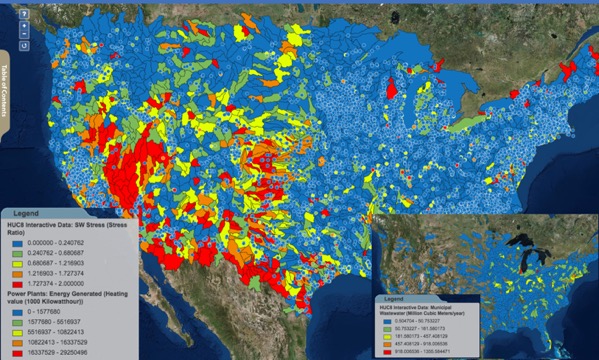
Analysis of Water Stress across the United States
HydroLearn

Problem Statement
The overall objective of this module is introduce concepts of water stress and how to quantify it according to water supply and demands at a watershed scale.
Module Overview
Water resource systems are faced with meeting the challenge of growing demands coupled with the potential for added stress from climate change in the coming decades. This module introduces students to the concept of water stress through set of data- and hypothesis-driven learning activities that assess water supply, demands and stresses over the entire domain of the Contiguous US. The analysis is conducted at the scale of eight-digit watershed hydrologic unit code (HUC8).
The learning activities guides students to examine water supply, both from surface and groundwater sources, and water use by different sectors (irrigation, municipal and industrial, and thermoelectric). Students calculate water stress indices at different U.S. basins and identify regions with water availability or shortages. Acknowledging the alarming rates of groundwater depletion in many US regions, students re-formulate the water stress indices focusing on groundwater, identify how much the thermoelectric sector is responsible for groundwater use, and explore opportunities for reducing groundwater use by tapping into non-traditional resources (e.g., treated domestic wastewater).
Topics Covered
(1) Analysis of water supply and demand
(2) Analysis of stress on surface and groundwater systems
(3) Sectoral analysis of water stresses
(4) Impact of environmental flows
(5) Analysis of groundwater depletion
Learning Objectives
At the end of this module, a student will be able to describe and implement the steps involved in surface and groundwater stress estimation and analysis.
This will be accomplished through activities within each section. Results from each activity will be recorded in specified results templates. The results templates for each activity can be found at the beginning of each activity. The results templates are organized such that results from one activity can easily be used in successive activities.
Prerequisites
N/A
Course Authors


Hisham Eldardiry
PhD Candidate, University of Washington Seattle. Contact: hishameldardiry@gmail.com
Hanz Unruh
PhD Candidate, University of Louisiana at Lafayette. Contact:C00062543@louisiana.edu
Vincent Tidwell
Sandia National Laboratories. Contact: vctidwe@sandia.govTarget Audience
Junior/Senior Hydrology and Water Resources Engineering Courses
Tools Needed
Computer with access to Internet, Excel, and free QGIS software
Course Sharing and Adaptation
This course is available for export by clicking the "Export Link" at the top right of this page. If you are an Instructor seeking the answer keys, please contact the course creators using your official University email account.
Make sure you cite the source of your new course (e.g., this course was adapted from --Include your course name here--). You can include this citation on an "Adaptation Page" of your new course, in your course card, or in the introduction section of your new course.
Recommended Citation
Habib, E., Tidwell, V., Eldardiry, H., Unruh, H. (2019) Analysis of Water Stress Across the United States. HydroLearn. https://edx.hydrolearn.org/courses/course-v1:HydroLearn+HydroLearn406+2019_S2/about.
Expected Total Hours
A student can expect to complete this module with approximately 18 work hours
